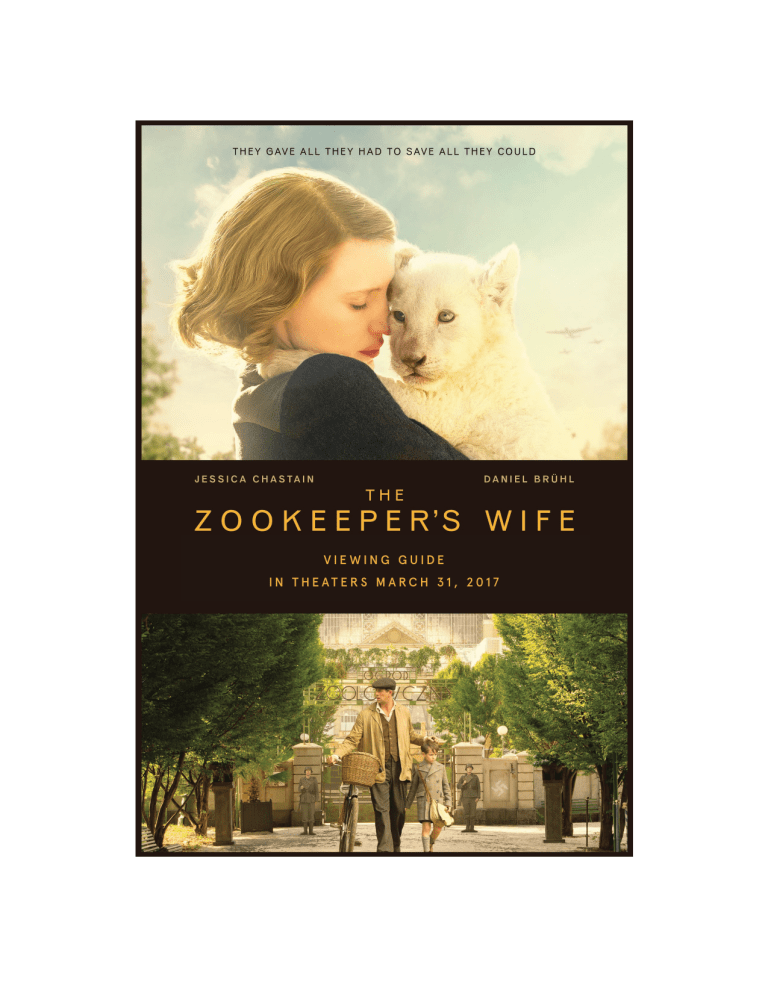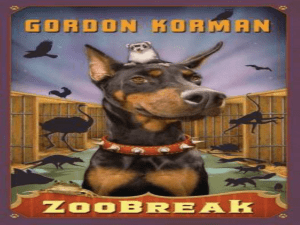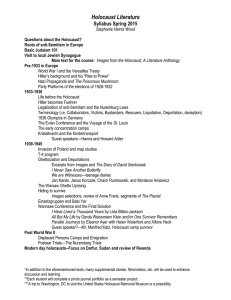
VIE WING GUIDE IN T HE AT E R S M A RC H 31 , 2017 THE ZOOKEEPER’S WIFE In the spirit of this heroic story, Focus Features has collaborated with humanitarian relief agencies from around the country, such as the International Rescue Committee (IRC), HIAS, CARE; and leading Jewish organizations to produce this viewing guide. Building on the legacy of the Żabińskis, these humanitarian organizations are at work providing lifesaving support to war-affected peoples worldwide. Learn more at: Rescue.org/ Zookeepers www.hias.org Care.org 2 THE ZOOKEEPER’S WIFE A BO U T T H E F I LM Two-time Academy Award nominee Jessica Chastain stars in The Zookeeper’s Wife in the title role of Antonina Żabińska, a real-life working wife and mother who became a hero to hundreds during WWII. Niki Caro (Whale Rider, North Country) directs the movie from a screenplay by Angela Workman, adapted from Diane Ackerman’s nonfiction book of the same name which was based on Antonina’s diaries. The time is 1939. The place is Poland, homeland of Antonina (portrayed by Ms. Chastain) and her husband, Dr. Jan Żabiński (Johan Heldenbergh, of The Broken Circle Breakdown). Devoted to each other, the couple thrive as personal and professional partners; the Warsaw Zoo flourishes under Jan’s stewardship and Antonina’s care. With reserves of energy, Antonina rises every day to tend to both her family and their menagerie, as the gates to the majestic zoo open in welcome . . . . . . until the entrance is slammed shut and the zoo is crippled in an attack as the entire country is invaded by the Germans. Stunned, the couple is forced to report to the Reich’s newly appointed chief zoologist, Lutz Heck (Golden Globe Award nominee Daniel Brühl of Captain America: Civil War). Heck envisions a new, selective breeding program for the zoo. Antonina and Jan fight back on their own terms, and covertly begin working with the Resistance—realizing that their zoo’s abandoned animal cages and underground tunnels, originally designed to safeguard animal life, can now secretly safeguard human life. As the couple puts into action plans to save lives out of what has become the Warsaw Ghetto, Antonina places herself and even her children at great risk. 3 THE ZOOKEEPER’S WIFE D I SC U S S I O N Q U E ST I O N 1. One of the most powerful scenes in The Zookeeper’s Wife comes when some of the Jews hiding in the Żabińskis’ zoo gather for a Passover Seder. As the characters sing, we see them recounting the story of how the Jewish people escaped a regime which enslaved and persecuted them finding freedom and redemption. We see a parallel between the Passover story and the situation of those hiding from the. In what way do the themes of Passover resonate today? Who is living under persecution or in need of redemption now and what can we do to help them? 3. One of Antonina’s defining characteristics is her empathy and willingness to fight for those people or animals who others ignore or write off. What was a moment in the film where you saw Antonia display these characteristics? Who today is most in need of your empathy and compassion?Antonina did not only shelter Jews, but provided them with as much comfort and hope as possible. What gives you hope in times of tragedy or fear? How can you provide that hope for others going through painful or difficult circumstances? How can you make them feel at home when they might have been kicked out or not be able to access their homes? 2. In the Passover Haggadah it is written, “Whoever is hungry, let him come and eat; whoever is in need, let him come and conduct the Seder of Passover.” Just as Antonina opened her home and gave of her property to shelter and care for the needy, one of the directives of this holiday’s text is for us to find ways to help care for those “in need.” How can we open our homes to those in need? What do we have to offer to those without? 4. While trying to connect with the young girl Urszula (Shira Haas), who Jan has rescued, Antonina acknowledges “what a terrible time” she must have had and how difficult that must make it to trust others. When someone has been through an especially painful or damaging situation, it can be challenging to open up or trust others, even to people who are trying to be of help. What are steps one could take to establish trust with someone who has been through or is going through traumatic circumstances? 5. In what ways do the circumstances that the Jewish people faced in Poland apply in society today? In what ways are they different? In what ways might Antonina’s brave example apply to us today? 4 THE ZOOKEEPER’S WIFE THEMES Protecting Human Rights There are steps we can all take to follow Antonina’s example to give hope and refuge for those in need. The International Rescue Committee provides lifesaving support to war-affected peoples worldwide, supplying refugees coming to America to flee persecution with the resources they require— from lessons in English to hot meals to communities to live in. You can honor the Żabińskis’ remarkable example by finding ways to take action in your own community. • Find the nearest refugee processing center near you and call them to find out how you can help support them. • Donate to the International Rescue Committee (IRC): www.Rescue.org/Zookeeper • Volunteer locally with refugees in your community. You can find a list of voluntary refugee aid agencies at https://www.acf.hhs.gov/orr/resource/voluntary-agencies. • Donate food, money or time to a local food pantry or shelter in your community. You can search for food pantries at foodpantries.org. • Send a CARE Package to refugees. Care.org provides vouchers to refugees for them to purchase the food and other items they determine most urgent for their families 5 THE ZOOKEEPER’S WIFE Remembering the Holocaust: From 1933–1945, six million Jews were systematically murdered along with millions of other innocent victims. Learning their stories, remembering their suffering and honoring their legacy is an important part of our society’s understanding of human rights and promoting the values of tolerance and respect that are critical to ensuring that oppression and genocide on the scale of the Holocaust are never again allowed. Here are some resources you can use to educate yourself and others about the Holocaust: • Yad VaShem, the World Holocaust Museum, located in Israel features informative and moving exhibits as well as a website with extensive digital collections and educational videos and materials. • The United States Holocaust Memorial Museum, located in Washington, D.C., also has a website with helpful resources for learning about the Holocaust as well as for fighting anti-semitism, Holocaust denial, and genocide. • The Museum of Tolerance in Los Angeles, an affiliate of the Simon Wiesenthal Center, has an initiative where they will work with schools or organizations to help them hear a Holocaust survivor, either in person or via video conference. • Facing History and Ourselves provides professional development and classroom resources to help students make the connection between history and the moral choices they make in their own lives. Facing History’s extensive Holocaust resource collection includes additional stories of rescue and resistance, and lessons on antisemitism. 6 THE ZOOKEEPER’S WIFE Anti-Semitism: Although the Holocaust is the most significant and horrific example of antisemitism, it a long history that did not begin or end with the Holocaust. Like so many forms of hate and religious intolerance, anti-semitism is on the rise in both the US and Europe. Here are some resources that you can use to be like the Żabińskis and take a stand against hate and intolerance. • If you witness an anti-semitic act, report it either to the police or the Anti-Defamation League, an organization dedicated to fighting anti-semitism. • Stay informed by subscribing to the newsletters of organizations that fight hate against Jews and all other groups, including the Anti-Defamation League, the Southern Poverty Law Center, and the Simon Wiesenthal Center. • The American Jewish Committee has a section on their website filled with ways for one to support the Jewish community on both national and local levels. 7 THE ZOOKEEPER’S WIFE CA ST & C R E W O F T HE ZO O K EEPER ’ S W I F E Cast: Crew: Antonina Żabińska Jessica Chastain Directed by Niki Caro Written by Angela Workman Jan Żabiński Johan Heldenbergh Based on the book The Zookeeper’s Wife by Diane Ackerman Lutz Heck Daniel Brühl Cinematography by Andrij Parekh Production Design by Suzie Davies Jerzyk Michael McElhatton Film Editing by David Coulson Maurycy Fraenkel Iddo Goldberg Make-up and Hair Design by Denise Kum Magda Gross Efrat Dor Costume Design by Sabine Daigeler Music by Harry Gregson-Williams Urszula Shira Haas Released by Focus Features Magda Gross Efrat Dor 8


